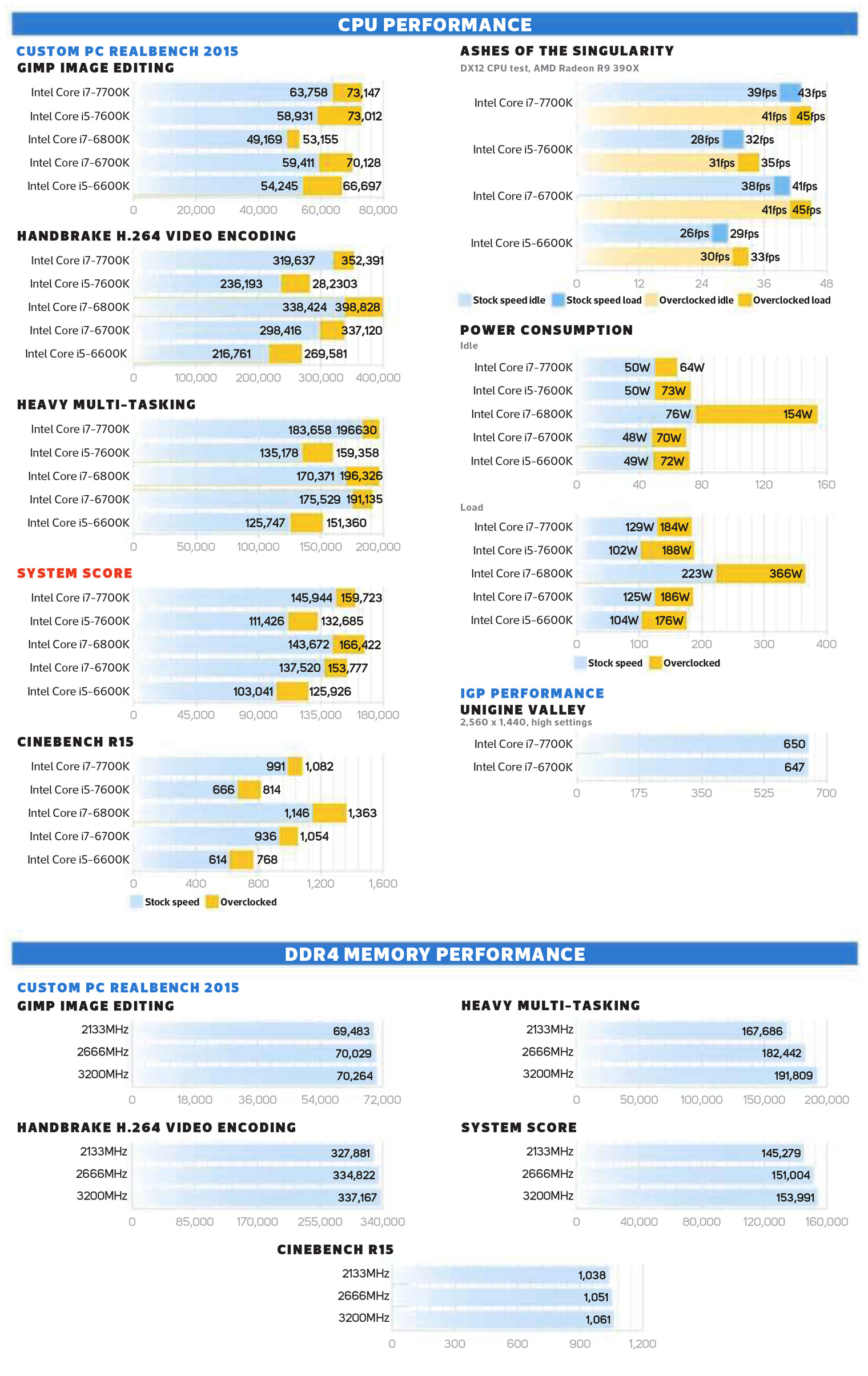Compared with the Core i7-6700K, not much has changed with the release of the 7700K, other than a clock speed bump, improved 4K video playback and a few optimizations. Both CPUs use the same 14nm manufacturing process, both are quad-core, Hyper-Threaded CPUs and both have 8MB of Level 3 cache with a 91W TDP. Indeed, forcing both CPUs to run at 4GHz sees identical results in Cinebench R15. The most significant changes are in the default clock speeds. The base clock has risen from 4GHz to 4.2GHz and the turbo frequency now stands at 4.5GHz, up from 4.2GHz. This difference accounts for the advantage seen at stock speed in our graphs, but that’s largely irrelevant for enthusiasts with an overclockable K-series CPU.
The integrated graphics processor (IGP) has also been upgraded to Intel HD 630, but it basically performs identically to its predecessor. It’s good to know that your existing LGA115x CPU cooler will work just fine again though – there’s been no socket change and Kaby Lake CPUs will also work fine in Z170 motherboards.
[amzn_product_inline asin=’B01MXSI216′]
Performance
Clock for clock, the Core i7-6700K should perform the same as the new Core i7-7700K, as only minor tweaks have been made to allow the new CPUs to operate at slightly higher frequencies. Any performance gains are down to the increased clock speeds, which are fairly significant. The Core i7-7700K edged out a 12,000 point lead in the system score on top of the 137,520 scored by the Core i7-6700K.
It also managed 991 points in Cinebench R15 as opposed to 936 for the older Skylake CPU and it knocked 12 seconds off the time to render our Terragen 3 file. The Core i5-7600K has also had a big clock bump, though, and the Core i7-7700K only pulls away from it in heavily multi-threaded software, such as Cinebench and our Handbrake video encoding test. Interestingly, the support for Hyper Threading also made the 7700K the quicker chip in our Ashes of the Singularity DirectX 12 gaming CPU test, where the 7700K’s minimum frame rate was 11fps ahead of that of the 7600K. You won’t see this advantage in many current games, but it’s possibly a sign of a future gaming advantage of the 7700K.
Our sample was a great overclocker too – we managed to get the 7700K to 5GHz using a vcore of just 1.36V, which could stand as a 24/7 overclock if you have good enough cooling. Of course, overclocking performance is always a lottery, but given the changes Intel has clearly made under the hood, we’re hopeful that most retail CPUs will overclock further than their Skylake counterparts.
Sadly, 5.1GHz was out of reach, as a huge hike in voltage was required, resulting in the chip getting too hot. Overclocking saw the system score in RealBench 2016 rise from 145,944 to 159,723 and the Cinebench score increase to 1,082. Meanwhile, power consumption was slightly higher than that of the 6700K at stock speed, but overall, there wasn’t much difference.
Conclusion
Ultimately, the Core i7-7700K is the fastest CPU available for Intel’s mainstream desktop platform, and while it’s admittedly just more of the same, it’s still a good CPU. It’s also great to see so much overclocking headroom in these early Kaby Lake samples; the 4K video engine makes 4K Netflix streaming possible and the DX12 gaming performance looks great as well. However, the main current reason to consider this chip over the Core i5-7600K is if you use a lot of heavily multi-threaded software, where it has a slight speed advantage – otherwise, the Core i5-7600K offers more bang per buck.




